This is an extraordinary story about crowdfunding avant la lettre and an urban 'bourgeoisie' that for once does not vote by refendum against throwing money at modern art. In Switzerland, no less. Kunstmuseum Basel made a small, fine, incisive exhibition about it, on show until 18 August, 2018. Ideal for a stopover on the way to Italy. If you do go for a swim in the Rhine, also so great.
The Miracle of Basel
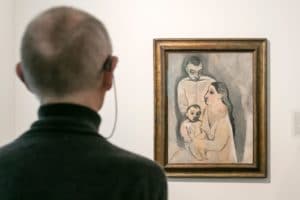
In 1967, a major problem unfolded at the Art Museum, since 1936 the most important museum/print room of the Swiss city Basel. The owner of Pablo Picasso's two masterpieces, on loan to the Art Museum for years, is in serious financial trouble due to a plane crash. In April 1967, one of his Globe Air planes crashes in Cyprus. 117 passengers and nine crew members are killed; the small airline quickly goes bankrupt. Major shareholder Peter G. Staechelin is forced to sell his large art collection on the international market.

A tragedy for the museum
This means a tragedy for the Art Museum: it will see its two greatest treasures and crowd-pleasers, Les deux frères (1906) and Arlequin assis (1923), both by Picasso, disappear abroad.
An unthinkable scenario. Management and museum friends spring into action. With the support of locals, they want to raise funds to buy the two paintings themselves. The art-loving riot is crowing in Basel. Through a legendary 'beggar's festival', among others, 2.4 million Swiss francs are raised.
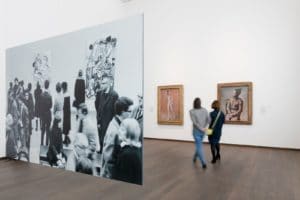 But then again, the asking price for the two Picassos is CHF 8.4 million. So there is still a shortfall of 6 million Swiss francs. If only the government wanted to make up the difference. The latter is wary and decides to put the question to the Baslers and Baslerinnen in a good old Swiss referendum.
But then again, the asking price for the two Picassos is CHF 8.4 million. So there is still a shortfall of 6 million Swiss francs. If only the government wanted to make up the difference. The latter is wary and decides to put the question to the Baslers and Baslerinnen in a good old Swiss referendum.
In the weeks leading up to the vote, virtually the entire city debates the sense and nonsense of modern art and, in particular, the importance of the two Picassos for Basel.
Are these two paintings worth our expensive tax money, was key question. Opponents and supporters, artists and committees, bankers and taxi drivers beat each other with arguments like tennis players (Roger Federer is from Basel).
 'Isn't 6 million a lot for those 'drawings'?' 'Shouldn't that money be used for more homes for the elderly?' 'Art can cost quite a bit.' 'In neighbourhood X they still don't have a library, in Y poor people still live, what about the crooked paving stones in the city centre, let's do something about that first!'
'Isn't 6 million a lot for those 'drawings'?' 'Shouldn't that money be used for more homes for the elderly?' 'Art can cost quite a bit.' 'In neighbourhood X they still don't have a library, in Y poor people still live, what about the crooked paving stones in the city centre, let's do something about that first!'
'Too much money for art?'
The battles are widely reported in the media. In the exhibition's opening room - under the slogan "Too much money for art?" - get an impression of the tumultuous discussions at taxi ranks and colleges, in the cafés and meeting rooms of autumnal Basel.
On 17 December 1967, the miracle happens. The ballots are counted. The result is fabulous: a vast majority of voters approve of the art edition. Students, artists, housewives, bakers and schoolchildren flood the streets and party late into the night.
Another miracle
Then comes Part 2 of the Great Miracle. From his hometown of Mougins, in France, the greatest painter of the 20th century has been following events in Basel with interest. Palblo Picasso invites Franz Meyer, the director of the Art Museum, to his studio. The 86-year-old painter was so moved by the Basler people's enthusiasm for his art that he wanted to donate two of his paintings to Basel. Franz Meyer chooses in
 consultation with Picasso the Vénus et l'amour and Le couple. 'These more or less belong together,' Meyer thought.
consultation with Picasso the Vénus et l'amour and Le couple. 'These more or less belong together,' Meyer thought.
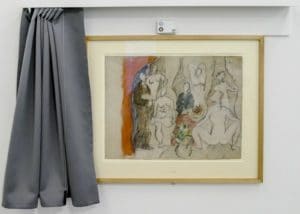
The cake is not over yet. Picasso has already decided to also donate a 1906 painting from his Pink Period painting. And as icing on the cake, Meyer may also select a sketch for the famous "Les Demoiselles d'Avignon", one of Picasso's first and best-known works from his Cubist period. The sketch, featuring ladies of easy virtue in lascivious positions, hangs in the current exhibition 'Art. Money. Museum.' behind a curtain.
'Is that curtain for the children?' I ask the stern attendant somewhat gullibly. 'Of course not,' she says soberly. 'It's an old drawing on old paper, very vulnerable to air and light'. For me, she pulls the curtain aside for a moment. One minute. Then she closes it resolutely.
Another Picasso gift
So the Art Museum is suddenly no less than six Picassos richer. But it is not finished yet. Austrian mecanas Maja Sacher-Stehlin adds an additional cubist painting by Picasso to the collection in all the revelry. Thus, a total of seven new Picassos are presented to the storm-tossed public at the Basel Art Museum in 1968.The acquisition of the seven Picasso paintings in 1967 and 1968, the Basel Miracle, is a milestone in the history of the Art Museum. Every reason to devote a beautiful, compact and lively exhibition to the two turbulent years 50 years later, in 2018.
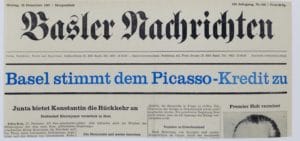 Five consecutive small rooms contain large images by photographer Kurt Wyss, who worked for the National-Zeitung in the 1960s. He captured director Meyer's visit to Picasso in Mougins in black-and-white photographs.
Five consecutive small rooms contain large images by photographer Kurt Wyss, who worked for the National-Zeitung in the 1960s. He captured director Meyer's visit to Picasso in Mougins in black-and-white photographs.
Naturally, Picasso's acquired works are present. On large tables are facsimile editions with newspaper clippings from a time without crowdfunding and social media. Interesting read. And there's a smooth movie with a mallot acting male with glasses who talks like he's not quite well but says some raunchy things.
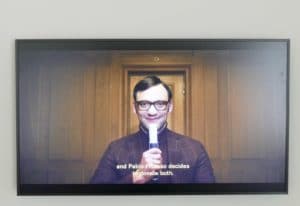 He leads us unswishly dashing through the 1967 Miracle, in the contemporary style of today's museum and art TV movies, in which a cheerful art quibble takes you past the collection. Think of Lucas de Man's quite entertaining appearance on 'our' Kunstuur.
He leads us unswishly dashing through the 1967 Miracle, in the contemporary style of today's museum and art TV movies, in which a cheerful art quibble takes you past the collection. Think of Lucas de Man's quite entertaining appearance on 'our' Kunstuur.
Robbery bank in old James Bond film
By the way: there is much more to do at Kunstmuseum Basel. As with many modern museums - a grand new wing came in 2016 - sometimes the building is more beautiful than the exhibitions. Kunstmuseum Basel now consists of three buildings. The Hauptbau, the Neubau and Gegenwart (the Museum of Modern Art), just down the street. The Neubau is large, grey and 'bunker-like', with the same mega-wide staircases as in the main building. The catacombs of the generously underground building are reminiscent of a looting bank in an old James Bond film.
To experience the beauty of the new building you actually have to walk outside, a long way into the Rittergasse opposite. Turn around and you see the state of the Neubau: a high, closed wall of grey-white, forming part of the sky, dominating the whole area. Inside, your first thought is: a waste of space. Or in the idiom of the Basel 1967 discussion: you could easily house three nursing homes here.

But then you miss two other intriguing exhibitions now running at the Neubau: American Theaster Gates' Black Madonna and Sam Giliam's The Music of Colour. There are also 40 other museums in Basel, including Fondation Beyeler, Switzerland's most visited museum.
 And again: plunge into the Rhine for a while. Hundreds of free-swimming Baselaars do that every day. Going with the flow and then walking back down the promenade in bikini or swimming trunks against the current to jump into the Rhine one more time. Basel is much more contemporary than you think.
And again: plunge into the Rhine for a while. Hundreds of free-swimming Baselaars do that every day. Going with the flow and then walking back down the promenade in bikini or swimming trunks against the current to jump into the Rhine one more time. Basel is much more contemporary than you think.
Art. Money. Museum. Kunstmuseum Basel, until 12 August 2018. www.kunstmuseumbasel.ch. All about Basel: see www.basel.com
